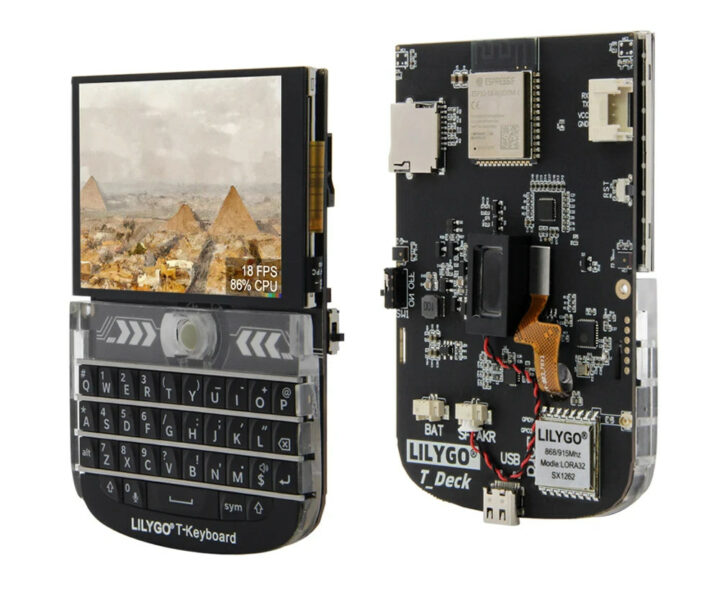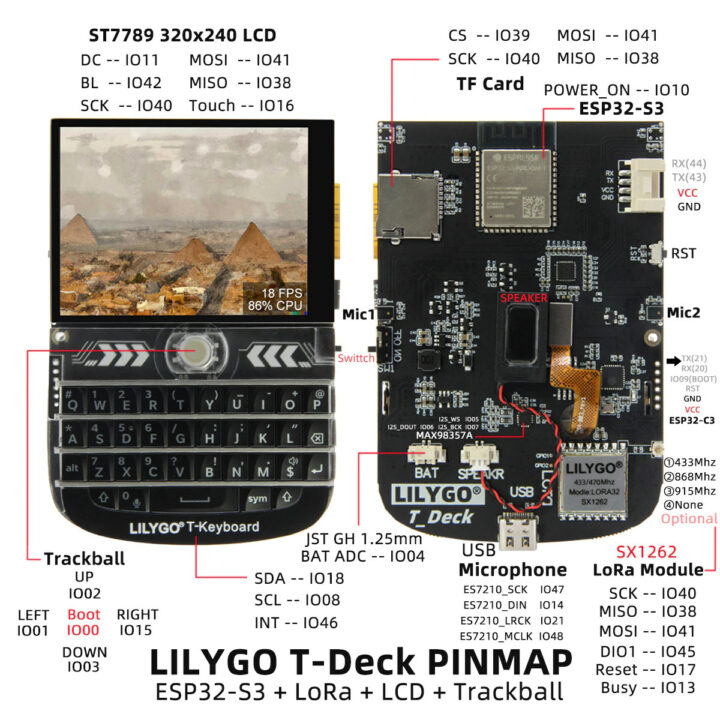LILYGO T-Deck is a development kit with an ESP32-S3 WiFi and BLE module, a 2.8-inch display with touchscreen support, a Blackberry-like keyboard based on ESP32-S3, and optional LoRaWAN connectivity through an SX1262 LoRa module.
It looks ideal for text-based messaging, but the devkit also includes two microphones and a speaker so audio communication must be possible. Other features include a MicroSD card slot, a Grove connector (UART) for expansion, and support for a LiPo battery with USB charging.
LILYGO T-Deck specifications:
- ESP32-S3-WROOM-1 wireless module
- SoC – ESP32-S3FN16R8 dual-core Tensilica LX7 microcontroller @ up to 240 MHz with
- 2.4 GHz 802.11n WiFi 4 and Bluetooth 5.0 LE connectivity
- Memory – 8MB PSRAM
- Storage – 16MB SPI flash
- PCB antenna
- SoC – ESP32-S3FN16R8 dual-core Tensilica LX7 microcontroller @ up to 240 MHz with
- Storage – MicroSD card slot
- Display – 2.8-inch IPS display with 320×240 resolution; ST7789 SPI display controller
- Audio – Built-in speaker using MAX98357A amplifier, 2x MEMS microphones
- Wireless
- 2.4 GHz 802.11n WiFi 4 and Bluetooth 5.0 LE connectivity (ESP32-S3)
- Optional SX1262 LoRa module @ 433/470 MHz or 868/915 MHz; up to +22 dBm Tx power
- USB – 1x USB Type-C port for power and programming
- User input
- LILYGO T-Keyboard with QWERTY design, ESP32-C3 microcontroller
- Trackball also acting as the BOOT button
- Reset button
- Expansion
- 4-pin Grove connector (UART)
- 6-pin header (unpopulated) connected to ESP32-C3 (T-Keyboard) with UART, BOOT/IO09, Reset, VCC, and GND
- Misc – On/off switch
- Power Supply
- 5V via USB Type-C port
- 2-pin JST connector for LiPo battery with ADC pin for battery voltage, TP4065B battery charger chip (based on schematics)
- Dimensions – 10 x 6.8 x 1.1 cm
LILYGO provides PDF schematic, 3D files for an enclosure, firmware files, and Arduino code samples both for the T-Keyboard (ESP32-C3) and T-Deck (ESP32-S3). The T-Keyboard only has one Arduino sketch making it run as an I2C slave keyboard, while the T-Deck has a keyboard sample to receive key codes from the T-Keyboard, as well as two simple code samples for the microphone and touchpad, and a more complex “UniTest” Arduino sketch designed for factory testing and which covers more features such as LoRa connectivity. Everything can be found on GitHub and somebody also got hold of a sample and tested the five samples as shown in the video below.
LILYGO hardware is better suited to more experienced users, as you’ll be expected to write the code yourself considering there aren’t any practical samples. As a solution that combines ESP32-S3, a keyboard, and a display, the T-Deck looks like a great candidate for the Meshtastic project for messaging over LoRa, but it’s unclear to me how much work is really to port it to the latest LILYGO gadget. I don’t expect the company to work on this, and this would probably have to be handled by the community.
The T-Deck devkit sells for $49.48 with free shipping on Aliexpress. That’s the price for the version without a LoRa module, and if you want a 433 MHz, 868 MHz, 915 MHz, the total price is $58.48 shipped, except for European users who need to take VAT into account…

Jean-Luc started CNX Software in 2010 as a part-time endeavor, before quitting his job as a software engineering manager, and starting to write daily news, and reviews full time later in 2011.
Support CNX Software! Donate via cryptocurrencies, become a Patron on Patreon, or purchase goods on Amazon or Aliexpress







I’ve just noticed the ESP32Berry project will be ported to the T-Deck. So there will be some useful firmware that work on the devkit.
This is exactly what I’m looking for (except the lack of a GPS) and it seems very well build. And there are some example codes on Github for neewbies to start with, so, … , yeah, well done Lyligo.
But for sure, it’s a bit expensive to get them here in Europe (74$ VAT and shiping included for the LoRa the version).
Would be great if they had a matching case available.
Looks nice, I agree with Bluepuma about a matching case though maybe one could 3d print something semi usable. Unfortunately the 2G and 3G phone networks in the US are now mostly shut down, so those cheap tiny GSM modules are no longer usable. I don’t know if there are any comparable modules for 4G.
Same situation in Australia so hopefully we see 4G in the future even though it will add to the overall cost.
I like the design and its well priced for the applications so here’s hoping they offer a matching cover to keep things protected.
Could this run some sort of DosBox? Looks perfect to play old 80s CRPGs like Ultima or Bards Tale.
It might, but other ESP32 boards that run DOS come with VGA: https://www.cnx-software.com/2023/05/26/olimex-esp32-sbc-fabgl-board-runs-dos-offers-vga-ps-2-keyboard-and-mouse-connectors/
So this would require some work.
A version with LTE would be 🔥
Honestly, I kinda feel like the ESP32-S3 is the wrong choice of a MCU here, as this would be ideally used with a battery and it’s not efficient for much of what it’s doing(e.g. graphics). Ideally, it would be a MCU with some graphic acceleration so it doesn’t need to go 50% usage on a idle screen at 15 FPS.
Same with how the ESP32-C3 is used for the keyboard, they could have chosen a more power efficient one just for that(say a simpler 8/16-bit MCU) as it’s just the keyboard really.
I think the CPU usage in this example isn’t a very representative case. LVGL demos (such as the music player one) have very low CPU usage when idle and still maintain 30fps on ESP32-S3, while driving a higher resolution display (800×480). Probably with a bit of optimization this demo can also achieve much better performance.